Evidence Based Practice Report: EARLY SAVE Program and Resuscitation
VerifiedAdded on 2020/05/08
|8
|2163
|53
Report
AI Summary
This report analyzes the effectiveness of the EARLY SAVE program in improving early recognition and response to clinical deterioration within a hospital setting, focusing on patient outcomes such as mortality rates, ICU transfers, and ward stays. The report also examines how data from the program can be used to report against National Safety and Quality Health Services (NSQHS) standards, particularly regarding the timely care of seriously ill patients. Furthermore, the report delves into the practice of resuscitation, discussing the procedure itself and the debate surrounding family presence during the process. It presents arguments both for and against family presence, referencing research findings that highlight the potential benefits, such as increased family confidence and reduced psychological trauma, as well as potential drawbacks, such as interference with medical procedures. The report concludes by emphasizing the importance of family involvement during resuscitation while acknowledging the complexities and considerations involved.
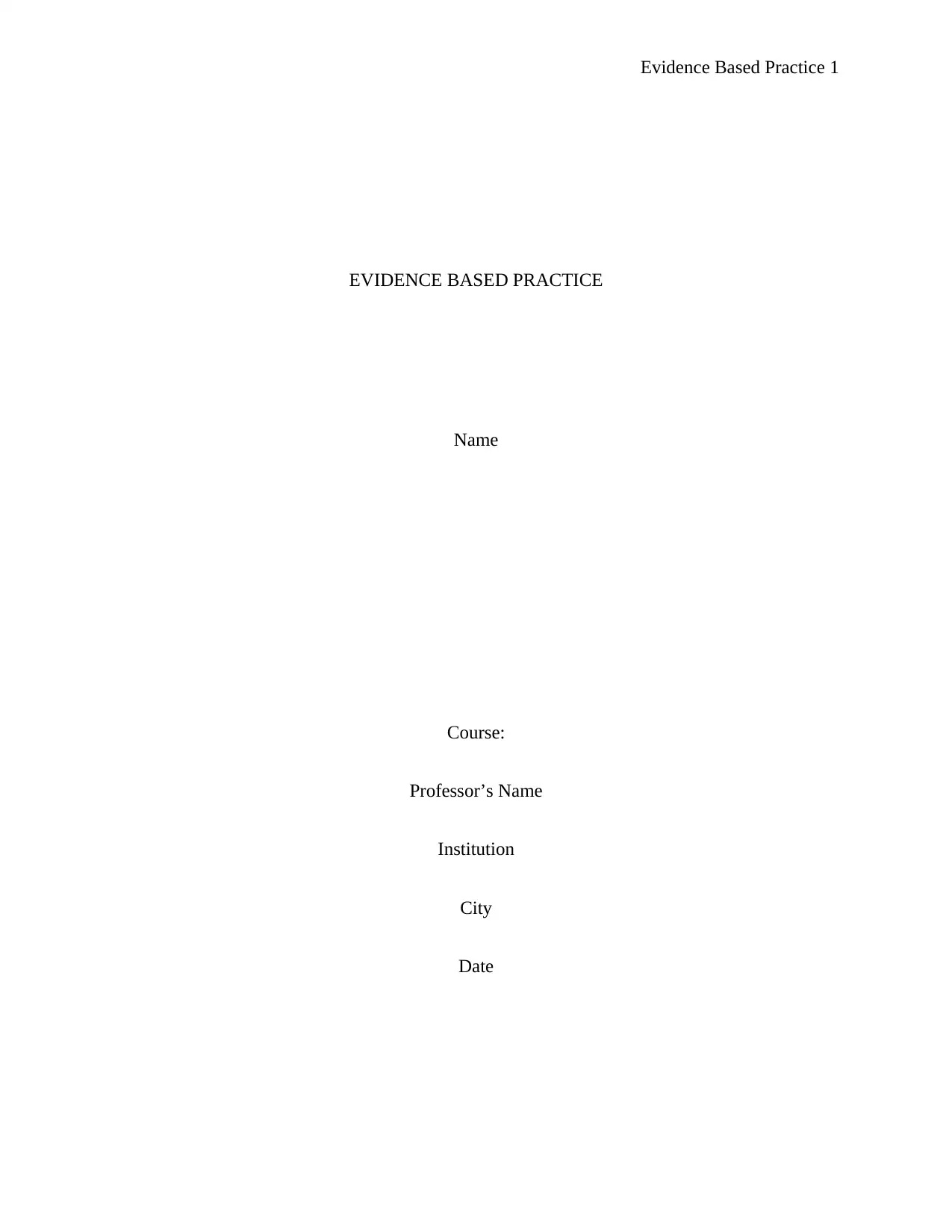
Evidence Based Practice 1
EVIDENCE BASED PRACTICE
Name
Course:
Professor’s Name
Institution
City
Date
EVIDENCE BASED PRACTICE
Name
Course:
Professor’s Name
Institution
City
Date
Paraphrase This Document
Need a fresh take? Get an instant paraphrase of this document with our AI Paraphraser

Evidence Based Practice 2
Evidence Based Practice
Part one
1. The EARLY SAVE has been effective in improving early recognition and response to
clinical deterioration in the hospital according to the patient outcome data presented by the
metropolitan hospital. The program works alongside the code blue program the (PRE EARLY
SAVE) that handles severe medical emergencies. The reason is that it has educated the clinical
staff on how well to handle the patients who suffer from serious ailments.
1. b).During the POST EARLY SAVE program, 50% of the individuals remained in the ward
without being transferred. That means that their condition was not critical. As such, the patients
were improving after the introduction of the program.
i). % of people who could not be resuscitated during the pre- EARLY SAVE program were 25%
% of people who could not be resuscitated during the post-EARLY SAVE program were 10%
This shows that the number of people who died before the program reduced to ten percent. It
showed that the early save program took quick steps in saving the lives of the patients.
ii). % of people who were transferred to the ICU during the pre-early save program were 35
while those who were transferred during the post EARLY SAVE program were 20. This shows
that the rate of admission to the ICU reduced since the introduction of the program. The Medical
Emergency Team took quick actions towards treating the patients.
iii). The % of people transferred to the HDU program during the pre -EARLY SAVE was 20.
The number of people transferred to the HDU program during the post ERALY SAVE
program was20.
The same percentage of people transferred to HDU shows that the program was successful in
handling the cases clinical deterioration. The High Dependence Unit accommodates people who
require a single organ support unlike those in the ICU who require multiple support.
Evidence Based Practice
Part one
1. The EARLY SAVE has been effective in improving early recognition and response to
clinical deterioration in the hospital according to the patient outcome data presented by the
metropolitan hospital. The program works alongside the code blue program the (PRE EARLY
SAVE) that handles severe medical emergencies. The reason is that it has educated the clinical
staff on how well to handle the patients who suffer from serious ailments.
1. b).During the POST EARLY SAVE program, 50% of the individuals remained in the ward
without being transferred. That means that their condition was not critical. As such, the patients
were improving after the introduction of the program.
i). % of people who could not be resuscitated during the pre- EARLY SAVE program were 25%
% of people who could not be resuscitated during the post-EARLY SAVE program were 10%
This shows that the number of people who died before the program reduced to ten percent. It
showed that the early save program took quick steps in saving the lives of the patients.
ii). % of people who were transferred to the ICU during the pre-early save program were 35
while those who were transferred during the post EARLY SAVE program were 20. This shows
that the rate of admission to the ICU reduced since the introduction of the program. The Medical
Emergency Team took quick actions towards treating the patients.
iii). The % of people transferred to the HDU program during the pre -EARLY SAVE was 20.
The number of people transferred to the HDU program during the post ERALY SAVE
program was20.
The same percentage of people transferred to HDU shows that the program was successful in
handling the cases clinical deterioration. The High Dependence Unit accommodates people who
require a single organ support unlike those in the ICU who require multiple support.
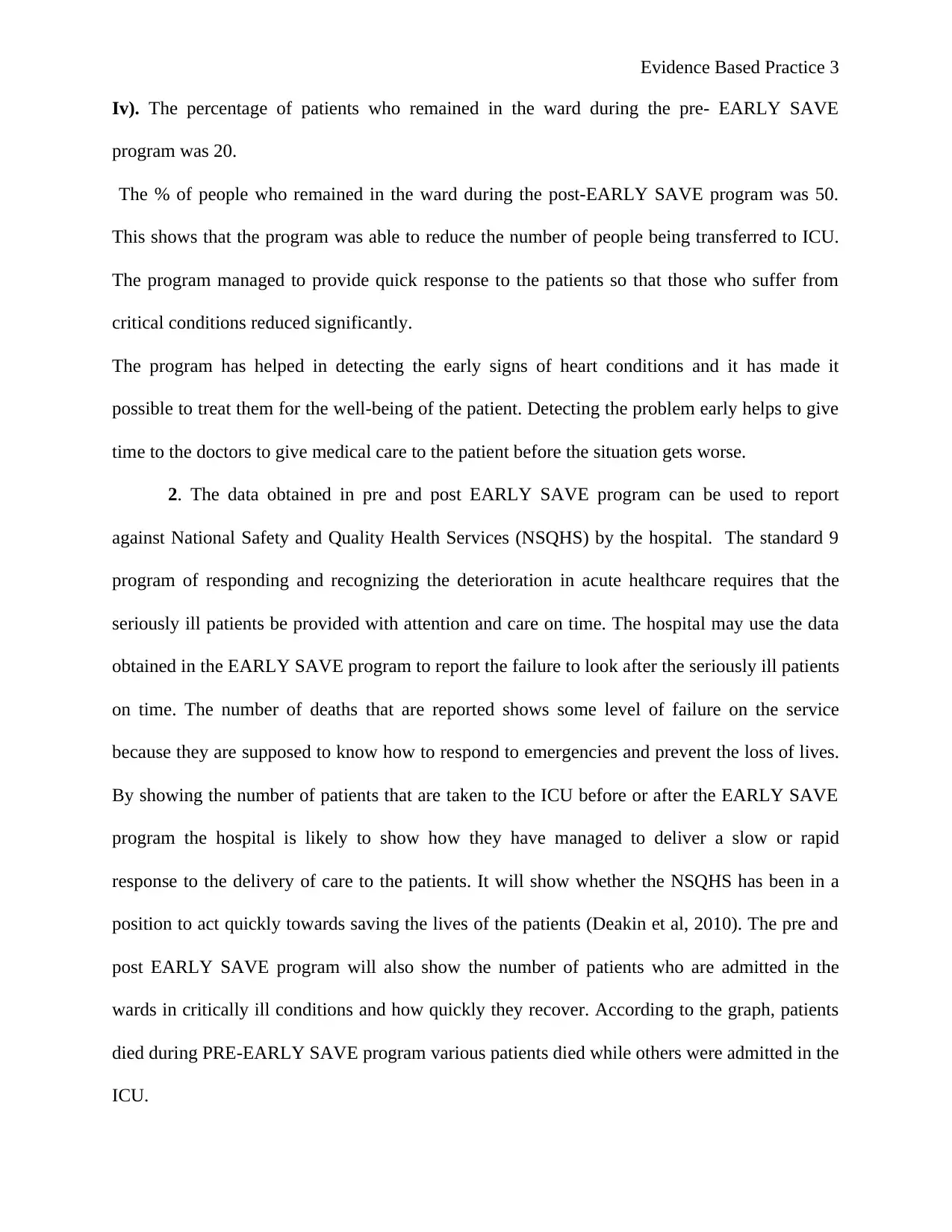
Evidence Based Practice 3
Iv). The percentage of patients who remained in the ward during the pre- EARLY SAVE
program was 20.
The % of people who remained in the ward during the post-EARLY SAVE program was 50.
This shows that the program was able to reduce the number of people being transferred to ICU.
The program managed to provide quick response to the patients so that those who suffer from
critical conditions reduced significantly.
The program has helped in detecting the early signs of heart conditions and it has made it
possible to treat them for the well-being of the patient. Detecting the problem early helps to give
time to the doctors to give medical care to the patient before the situation gets worse.
2. The data obtained in pre and post EARLY SAVE program can be used to report
against National Safety and Quality Health Services (NSQHS) by the hospital. The standard 9
program of responding and recognizing the deterioration in acute healthcare requires that the
seriously ill patients be provided with attention and care on time. The hospital may use the data
obtained in the EARLY SAVE program to report the failure to look after the seriously ill patients
on time. The number of deaths that are reported shows some level of failure on the service
because they are supposed to know how to respond to emergencies and prevent the loss of lives.
By showing the number of patients that are taken to the ICU before or after the EARLY SAVE
program the hospital is likely to show how they have managed to deliver a slow or rapid
response to the delivery of care to the patients. It will show whether the NSQHS has been in a
position to act quickly towards saving the lives of the patients (Deakin et al, 2010). The pre and
post EARLY SAVE program will also show the number of patients who are admitted in the
wards in critically ill conditions and how quickly they recover. According to the graph, patients
died during PRE-EARLY SAVE program various patients died while others were admitted in the
ICU.
Iv). The percentage of patients who remained in the ward during the pre- EARLY SAVE
program was 20.
The % of people who remained in the ward during the post-EARLY SAVE program was 50.
This shows that the program was able to reduce the number of people being transferred to ICU.
The program managed to provide quick response to the patients so that those who suffer from
critical conditions reduced significantly.
The program has helped in detecting the early signs of heart conditions and it has made it
possible to treat them for the well-being of the patient. Detecting the problem early helps to give
time to the doctors to give medical care to the patient before the situation gets worse.
2. The data obtained in pre and post EARLY SAVE program can be used to report
against National Safety and Quality Health Services (NSQHS) by the hospital. The standard 9
program of responding and recognizing the deterioration in acute healthcare requires that the
seriously ill patients be provided with attention and care on time. The hospital may use the data
obtained in the EARLY SAVE program to report the failure to look after the seriously ill patients
on time. The number of deaths that are reported shows some level of failure on the service
because they are supposed to know how to respond to emergencies and prevent the loss of lives.
By showing the number of patients that are taken to the ICU before or after the EARLY SAVE
program the hospital is likely to show how they have managed to deliver a slow or rapid
response to the delivery of care to the patients. It will show whether the NSQHS has been in a
position to act quickly towards saving the lives of the patients (Deakin et al, 2010). The pre and
post EARLY SAVE program will also show the number of patients who are admitted in the
wards in critically ill conditions and how quickly they recover. According to the graph, patients
died during PRE-EARLY SAVE program various patients died while others were admitted in the
ICU.
⊘ This is a preview!⊘
Do you want full access?
Subscribe today to unlock all pages.

Trusted by 1+ million students worldwide
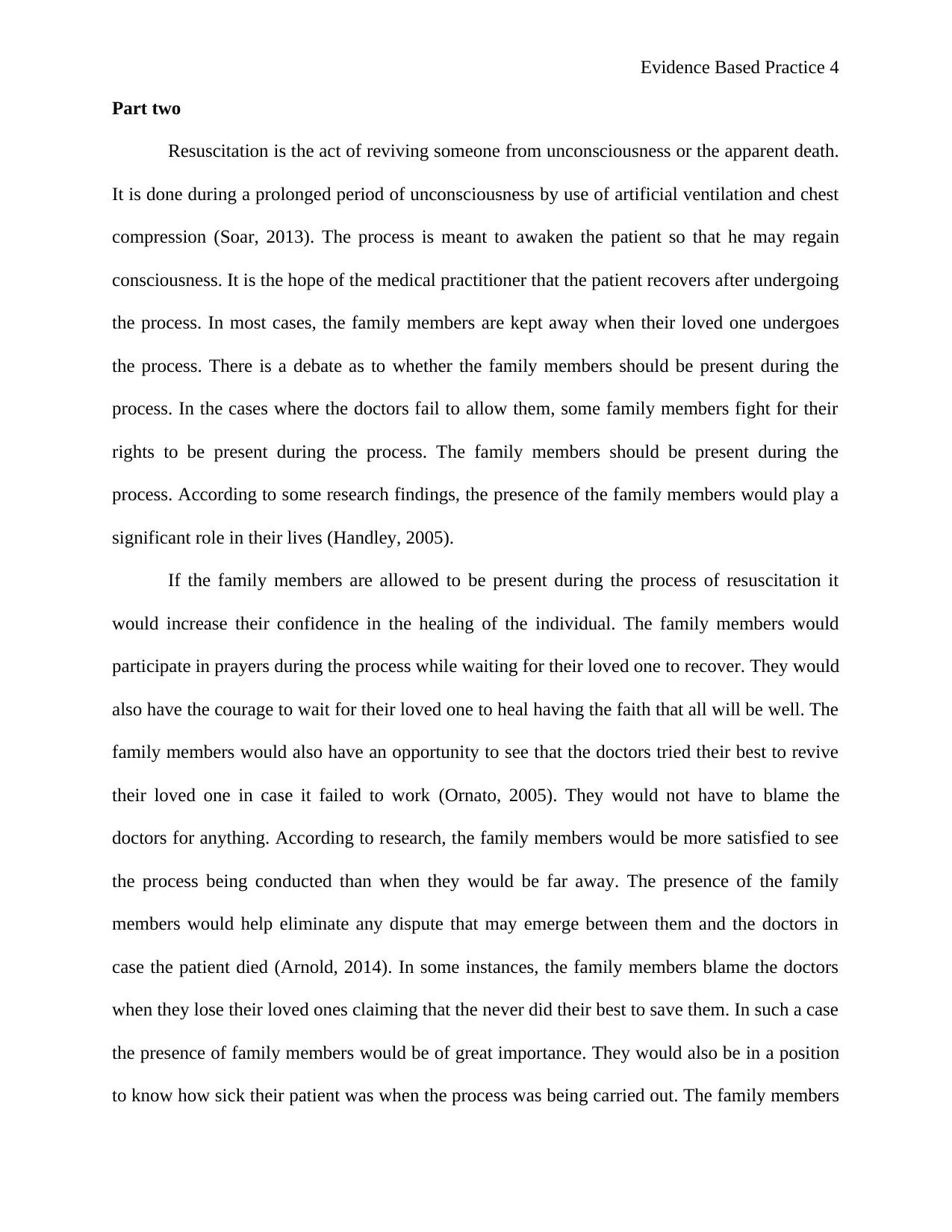
Evidence Based Practice 4
Part two
Resuscitation is the act of reviving someone from unconsciousness or the apparent death.
It is done during a prolonged period of unconsciousness by use of artificial ventilation and chest
compression (Soar, 2013). The process is meant to awaken the patient so that he may regain
consciousness. It is the hope of the medical practitioner that the patient recovers after undergoing
the process. In most cases, the family members are kept away when their loved one undergoes
the process. There is a debate as to whether the family members should be present during the
process. In the cases where the doctors fail to allow them, some family members fight for their
rights to be present during the process. The family members should be present during the
process. According to some research findings, the presence of the family members would play a
significant role in their lives (Handley, 2005).
If the family members are allowed to be present during the process of resuscitation it
would increase their confidence in the healing of the individual. The family members would
participate in prayers during the process while waiting for their loved one to recover. They would
also have the courage to wait for their loved one to heal having the faith that all will be well. The
family members would also have an opportunity to see that the doctors tried their best to revive
their loved one in case it failed to work (Ornato, 2005). They would not have to blame the
doctors for anything. According to research, the family members would be more satisfied to see
the process being conducted than when they would be far away. The presence of the family
members would help eliminate any dispute that may emerge between them and the doctors in
case the patient died (Arnold, 2014). In some instances, the family members blame the doctors
when they lose their loved ones claiming that the never did their best to save them. In such a case
the presence of family members would be of great importance. They would also be in a position
to know how sick their patient was when the process was being carried out. The family members
Part two
Resuscitation is the act of reviving someone from unconsciousness or the apparent death.
It is done during a prolonged period of unconsciousness by use of artificial ventilation and chest
compression (Soar, 2013). The process is meant to awaken the patient so that he may regain
consciousness. It is the hope of the medical practitioner that the patient recovers after undergoing
the process. In most cases, the family members are kept away when their loved one undergoes
the process. There is a debate as to whether the family members should be present during the
process. In the cases where the doctors fail to allow them, some family members fight for their
rights to be present during the process. The family members should be present during the
process. According to some research findings, the presence of the family members would play a
significant role in their lives (Handley, 2005).
If the family members are allowed to be present during the process of resuscitation it
would increase their confidence in the healing of the individual. The family members would
participate in prayers during the process while waiting for their loved one to recover. They would
also have the courage to wait for their loved one to heal having the faith that all will be well. The
family members would also have an opportunity to see that the doctors tried their best to revive
their loved one in case it failed to work (Ornato, 2005). They would not have to blame the
doctors for anything. According to research, the family members would be more satisfied to see
the process being conducted than when they would be far away. The presence of the family
members would help eliminate any dispute that may emerge between them and the doctors in
case the patient died (Arnold, 2014). In some instances, the family members blame the doctors
when they lose their loved ones claiming that the never did their best to save them. In such a case
the presence of family members would be of great importance. They would also be in a position
to know how sick their patient was when the process was being carried out. The family members
Paraphrase This Document
Need a fresh take? Get an instant paraphrase of this document with our AI Paraphraser

Evidence Based Practice 5
often raise their expectations too high and trust the effort of the doctors too much such that the
always find them at fault in case the patient dies (Craft-Rosenberg, 2011).
Their presence in the resuscitation room would help them see that the doctors did their
best and thus fail to blame them. The family members will have the evidence that the doctors did
everything possible to help save the life of their loved one. In case their loved one dies in their
presence, it will help them come to terms that death is real and it can occur to anyone. The
family members will have the opportunity to confess to their friends that everything possible was
done to save their loved one (Nolan et al, 2008). The presence of the family members during this
process would help clear any suspicions that the family members had regarding their loved one
(Champ-Gibson, 2016). It would also help reduce the instances of post-traumatic stress disorder
on the family members according to recent research (Snyder & Gauthier, 2008). The reason is
that they will have faced the situation in the hospital and accept its reality. The presence of
family members during the process would also ease the stress of the doctors of conveying the
news of the death of a loved one to them. It would not be difficult for the doctors to reveal what
happened to the family members because they were present during the process. The doctor
would also have time to comfort the family members during the trying moment. Nevertheless,
some research findings indicate that the presence of the family members during the process of
resuscitation would make them interfere with the process (Tang, 2012). The reason is that some
of them may shout or yell when the process is being conducted. Some family members may fail
to stand what their loved one is going through and thus may fail to control themselves after
seeing the process being undertaken on their loved one. The action may interfere with the smooth
running of the process. In such a case it may be argued that they be absent during the process if
they will fail to manage their emotions. It is also argued that the family members witnessing the
procedure may suffer from psychological trauma (Hance, 2014). However, it is important for the
often raise their expectations too high and trust the effort of the doctors too much such that the
always find them at fault in case the patient dies (Craft-Rosenberg, 2011).
Their presence in the resuscitation room would help them see that the doctors did their
best and thus fail to blame them. The family members will have the evidence that the doctors did
everything possible to help save the life of their loved one. In case their loved one dies in their
presence, it will help them come to terms that death is real and it can occur to anyone. The
family members will have the opportunity to confess to their friends that everything possible was
done to save their loved one (Nolan et al, 2008). The presence of the family members during this
process would help clear any suspicions that the family members had regarding their loved one
(Champ-Gibson, 2016). It would also help reduce the instances of post-traumatic stress disorder
on the family members according to recent research (Snyder & Gauthier, 2008). The reason is
that they will have faced the situation in the hospital and accept its reality. The presence of
family members during the process would also ease the stress of the doctors of conveying the
news of the death of a loved one to them. It would not be difficult for the doctors to reveal what
happened to the family members because they were present during the process. The doctor
would also have time to comfort the family members during the trying moment. Nevertheless,
some research findings indicate that the presence of the family members during the process of
resuscitation would make them interfere with the process (Tang, 2012). The reason is that some
of them may shout or yell when the process is being conducted. Some family members may fail
to stand what their loved one is going through and thus may fail to control themselves after
seeing the process being undertaken on their loved one. The action may interfere with the smooth
running of the process. In such a case it may be argued that they be absent during the process if
they will fail to manage their emotions. It is also argued that the family members witnessing the
procedure may suffer from psychological trauma (Hance, 2014). However, it is important for the
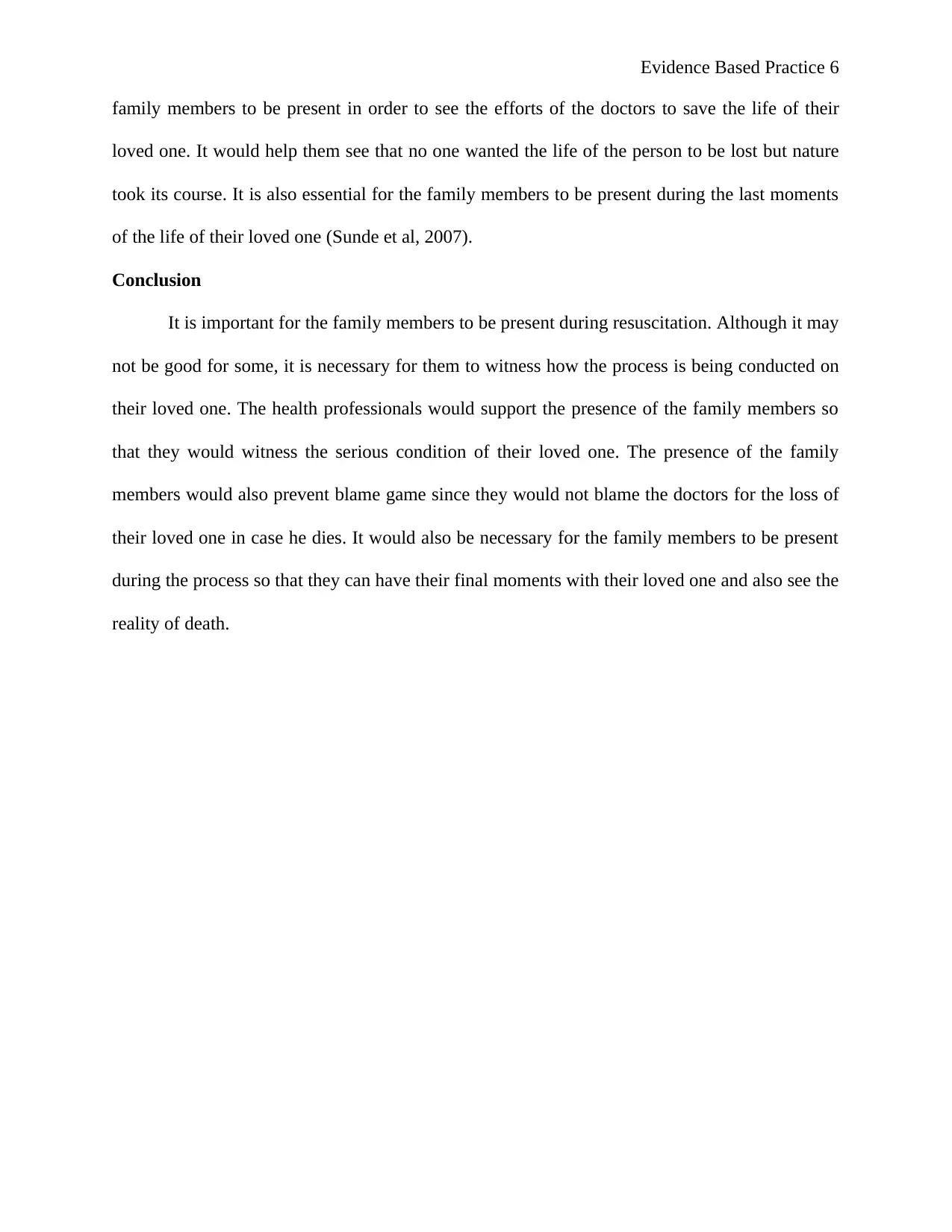
Evidence Based Practice 6
family members to be present in order to see the efforts of the doctors to save the life of their
loved one. It would help them see that no one wanted the life of the person to be lost but nature
took its course. It is also essential for the family members to be present during the last moments
of the life of their loved one (Sunde et al, 2007).
Conclusion
It is important for the family members to be present during resuscitation. Although it may
not be good for some, it is necessary for them to witness how the process is being conducted on
their loved one. The health professionals would support the presence of the family members so
that they would witness the serious condition of their loved one. The presence of the family
members would also prevent blame game since they would not blame the doctors for the loss of
their loved one in case he dies. It would also be necessary for the family members to be present
during the process so that they can have their final moments with their loved one and also see the
reality of death.
family members to be present in order to see the efforts of the doctors to save the life of their
loved one. It would help them see that no one wanted the life of the person to be lost but nature
took its course. It is also essential for the family members to be present during the last moments
of the life of their loved one (Sunde et al, 2007).
Conclusion
It is important for the family members to be present during resuscitation. Although it may
not be good for some, it is necessary for them to witness how the process is being conducted on
their loved one. The health professionals would support the presence of the family members so
that they would witness the serious condition of their loved one. The presence of the family
members would also prevent blame game since they would not blame the doctors for the loss of
their loved one in case he dies. It would also be necessary for the family members to be present
during the process so that they can have their final moments with their loved one and also see the
reality of death.
⊘ This is a preview!⊘
Do you want full access?
Subscribe today to unlock all pages.

Trusted by 1+ million students worldwide
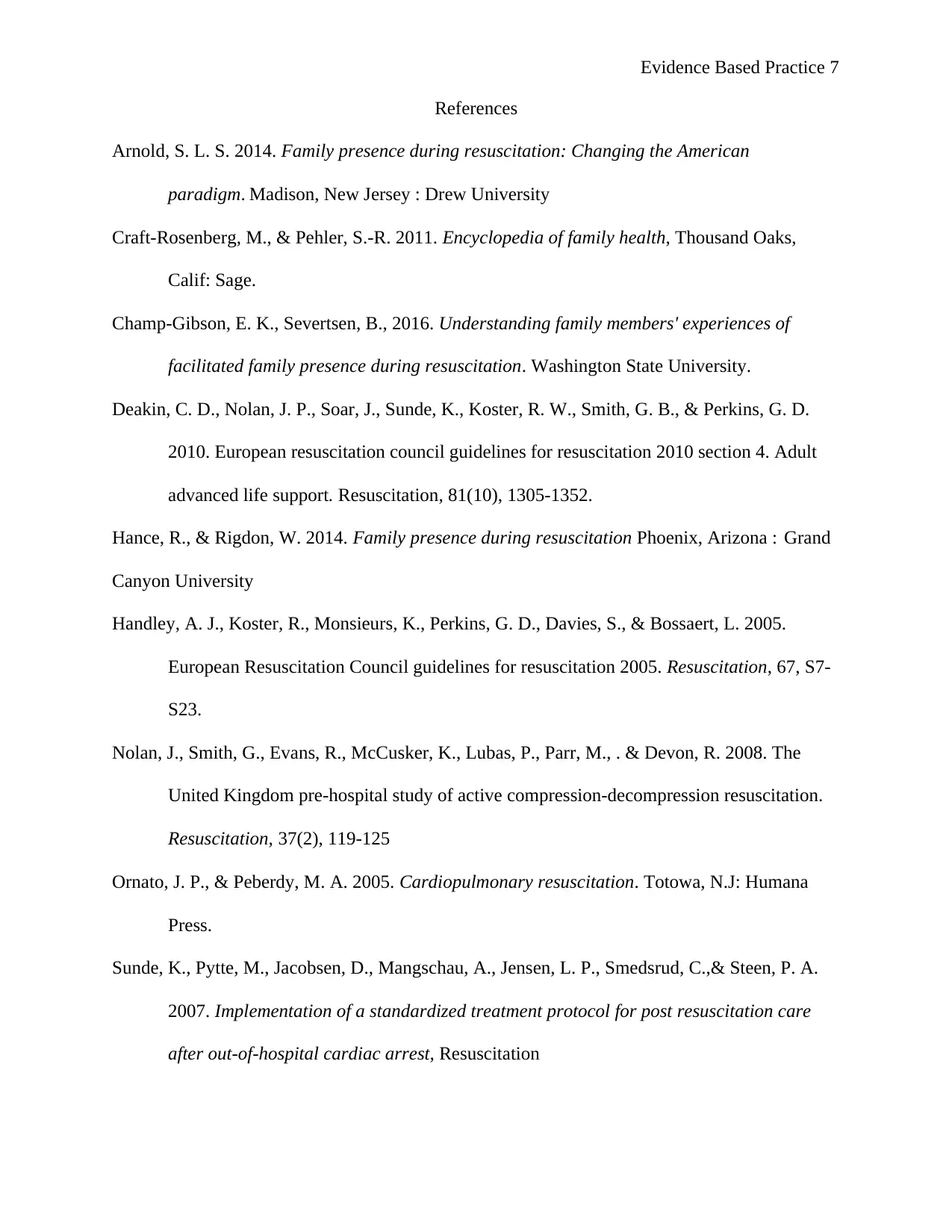
Evidence Based Practice 7
References
Arnold, S. L. S. 2014. Family presence during resuscitation: Changing the American
paradigm. Madison, New Jersey : Drew University
Craft-Rosenberg, M., & Pehler, S.-R. 2011. Encyclopedia of family health, Thousand Oaks,
Calif: Sage.
Champ-Gibson, E. K., Severtsen, B., 2016. Understanding family members' experiences of
facilitated family presence during resuscitation. Washington State University.
Deakin, C. D., Nolan, J. P., Soar, J., Sunde, K., Koster, R. W., Smith, G. B., & Perkins, G. D.
2010. European resuscitation council guidelines for resuscitation 2010 section 4. Adult
advanced life support. Resuscitation, 81(10), 1305-1352.
Hance, R., & Rigdon, W. 2014. Family presence during resuscitation Phoenix, Arizona : Grand
Canyon University
Handley, A. J., Koster, R., Monsieurs, K., Perkins, G. D., Davies, S., & Bossaert, L. 2005.
European Resuscitation Council guidelines for resuscitation 2005. Resuscitation, 67, S7-
S23.
Nolan, J., Smith, G., Evans, R., McCusker, K., Lubas, P., Parr, M., . & Devon, R. 2008. The
United Kingdom pre-hospital study of active compression-decompression resuscitation.
Resuscitation, 37(2), 119-125
Ornato, J. P., & Peberdy, M. A. 2005. Cardiopulmonary resuscitation. Totowa, N.J: Humana
Press.
Sunde, K., Pytte, M., Jacobsen, D., Mangschau, A., Jensen, L. P., Smedsrud, C.,& Steen, P. A.
2007. Implementation of a standardized treatment protocol for post resuscitation care
after out-of-hospital cardiac arrest, Resuscitation
References
Arnold, S. L. S. 2014. Family presence during resuscitation: Changing the American
paradigm. Madison, New Jersey : Drew University
Craft-Rosenberg, M., & Pehler, S.-R. 2011. Encyclopedia of family health, Thousand Oaks,
Calif: Sage.
Champ-Gibson, E. K., Severtsen, B., 2016. Understanding family members' experiences of
facilitated family presence during resuscitation. Washington State University.
Deakin, C. D., Nolan, J. P., Soar, J., Sunde, K., Koster, R. W., Smith, G. B., & Perkins, G. D.
2010. European resuscitation council guidelines for resuscitation 2010 section 4. Adult
advanced life support. Resuscitation, 81(10), 1305-1352.
Hance, R., & Rigdon, W. 2014. Family presence during resuscitation Phoenix, Arizona : Grand
Canyon University
Handley, A. J., Koster, R., Monsieurs, K., Perkins, G. D., Davies, S., & Bossaert, L. 2005.
European Resuscitation Council guidelines for resuscitation 2005. Resuscitation, 67, S7-
S23.
Nolan, J., Smith, G., Evans, R., McCusker, K., Lubas, P., Parr, M., . & Devon, R. 2008. The
United Kingdom pre-hospital study of active compression-decompression resuscitation.
Resuscitation, 37(2), 119-125
Ornato, J. P., & Peberdy, M. A. 2005. Cardiopulmonary resuscitation. Totowa, N.J: Humana
Press.
Sunde, K., Pytte, M., Jacobsen, D., Mangschau, A., Jensen, L. P., Smedsrud, C.,& Steen, P. A.
2007. Implementation of a standardized treatment protocol for post resuscitation care
after out-of-hospital cardiac arrest, Resuscitation
Paraphrase This Document
Need a fresh take? Get an instant paraphrase of this document with our AI Paraphraser
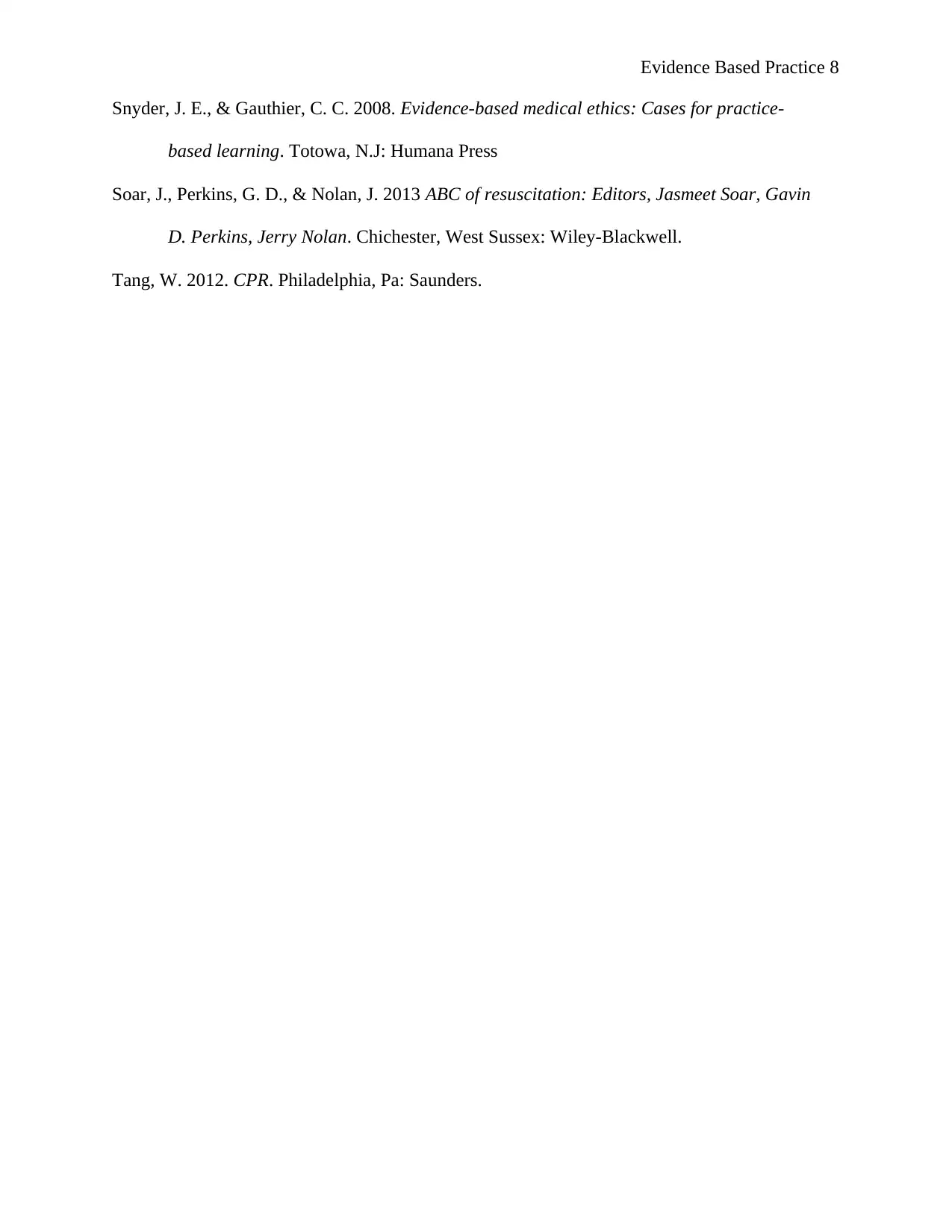
Evidence Based Practice 8
Snyder, J. E., & Gauthier, C. C. 2008. Evidence-based medical ethics: Cases for practice-
based learning. Totowa, N.J: Humana Press
Soar, J., Perkins, G. D., & Nolan, J. 2013 ABC of resuscitation: Editors, Jasmeet Soar, Gavin
D. Perkins, Jerry Nolan. Chichester, West Sussex: Wiley-Blackwell.
Tang, W. 2012. CPR. Philadelphia, Pa: Saunders.
Snyder, J. E., & Gauthier, C. C. 2008. Evidence-based medical ethics: Cases for practice-
based learning. Totowa, N.J: Humana Press
Soar, J., Perkins, G. D., & Nolan, J. 2013 ABC of resuscitation: Editors, Jasmeet Soar, Gavin
D. Perkins, Jerry Nolan. Chichester, West Sussex: Wiley-Blackwell.
Tang, W. 2012. CPR. Philadelphia, Pa: Saunders.
1 out of 8
Related Documents
Your All-in-One AI-Powered Toolkit for Academic Success.
+13062052269
info@desklib.com
Available 24*7 on WhatsApp / Email
![[object Object]](/_next/static/media/star-bottom.7253800d.svg)
Unlock your academic potential
Copyright © 2020–2025 A2Z Services. All Rights Reserved. Developed and managed by ZUCOL.





